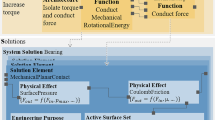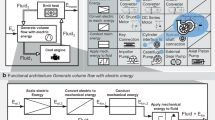Abstract
Product development is characterised by numerous synthesis and analysis loops. Analysis provides information on the fulfillment of the required properties of the system under development. Analysis results therefore are an important basis for further synthesis steps. In the context of Model-Based Systems Engineering (MBSE), different types of simulation models play an important role. The overall system (product) can be broken down to system elements. For each system element a set of models has to be established, that provides the required degrees of fidelity, representations of system properties, flows, etc. reflecting the variety of modelling purposes. These models have to be integrated horizontally (same system level along the relevant flows of material, energy, and information) and vertically (aggregation from subsystem level to the overall system level, refinement in the opposite direction) to create a holistic model-based system representation. An important and challenging task is to identify and shape relevant subsystem models. In order to define an appropriate structure of these models, model developers may utilize criteria like selected properties of system elements and interrelations, their degree of detail or modelling assumptions. The relevant criteria have to be made transparent. For this purpose, the paper discusses the concept of model signatures that contain relevant meta information about each single model of all system elements, subsystems up to models of the overall system. This standardized meta information enables an identification and selection of those models and the decision on the necessary model integration. The concept is discussed on the basis of a roller bearing as an example out of an electro-mechanical drivetrain. A potential analysis provides information about the possible usage of the model signatures concept.
Access this chapter
Tax calculation will be finalised at checkout
Purchases are for personal use only
Similar content being viewed by others
References
Weber, C., Husung, S.: Virtualisation of product development/design - seen from design theory and methodology. In: 18th International Conference on Engineering Design (ICED 2011), pp. 226–235 (2011)
VDI: Entwicklung technischer Produkte und Systeme/Design of technical products and systems. Blatt 2 (VDI 2221:2019) (2019)
Ropohl, G.: Systemtechnik. Grundlagen und Anwendung, Hanser, München (1975)
Ariyo, O.O., Eckert, C.M., Clarkson, P.J.: Hierarchical decompositions for complex product representation. In: 10th International Design Conference, pp. 737–744 (2008)
Browning, T.R.: Applying the design structure matrix to system decomposition and integration problems: a review and new directions. IEEE Trans. Eng. Manag. 48(3), 292–306 (2001). https://doi.org/10.1109/17.946528
Jacobs, G., Konrad, C., Berroth, J., Zerwas, T., Höpfner, G., Spütz, K.: Function-oriented model-based product development. In: Krause, D., Heyden, E. (eds.) Design Methodology for Future Products, pp. 243–263. Springer, Cham (2022). https://doi.org/10.1007/978-3-030-78368-6_13
VDI: Entwicklungsmethodik für mechatronische Systeme/Design methodology for mechatronic systems (VDI 2206:2004) (2004)
Rumpe, B.: Modeling with UML. Language, Concepts, Methods. Springer eBook Collection Computer Science. Springer, Cham (2016). https://doi.org/10.1007/978-3-319-33933-7
Friedenthal, S., Moore, A., Steiner, R.: A Practical Guide to SysML: The Systems Modeling Language, 3rd edn. The MK/OMG Press, Burlington (2015)
Husung, S., Weber, C., Mahboob, A.: Model-based systems engineering: a new way for function-driven product development. In: Krause, D., Heyden, E. (eds.) Design Methodology for Future Products, pp. 221–241. Springer, Cham (2022). https://doi.org/10.1007/978-3-030-78368-6_12
Zerwas, T., et al.: Mechanical concept development using principle solution models. In: IOP Conference Series: Materials Science and Engineering, p. 012001 (2021). https://doi.org/10.1088/1757-899X/1097/1/012001
Hick, H., Bajzek, M., Faustmann, C.: Definition of a system model for model-based development. SN Appl. Sci. 1(9), 1–15 (2019). https://doi.org/10.1007/s42452-019-1069-0
Blochwitz, T., et al.: The functional mockup interface for tool independent exchange of simulation models. In: Proceedings of the 8th International Modelica Conference, pp. 105–114 (2011)
Bretz, L., Tschirner, C., Dumitrescu, R.: A concept for managing information in early stages of product engineering by integrating MBSE and workflow management systems. In: IEEE International Symposium on Systems Engineering (ISSE), pp. 1–8 (2016)
Heber, D.T., Groll, M.W.: A meta-model to connect model-based systems engineering with product data management by dint of the blockchain. In: IEEE International Conference on Intelligent Systems (IS), pp. 280–287 (2018). https://doi.org/10.1109/IS.2018.8710527
Kirsch, L., Müller, P., Eigner, M., Muggeo, C.: SysML-Modellverwaltung im PDM/PLM-Umfeld. In: Tag des Systems Engineering, pp. 333–342. Carl Hanser (2016)
Wang, C.: MBSE-compliant product lifecycle model management. In: 14th Annual Conference System of Systems Engineering (SoSE), pp. 248–253. IEEE (2019). https://doi.org/10.1109/SYSOSE.2019.8753869
Parrott, E.L., Spayd, L.C.: Configuration and data management of the NASA power and propulsion element MBSE model(s). In: 2020 IEEE Aerospace Conference, pp. 1–11. IEEE (2020). https://doi.org/10.1109/AERO47225.2020.9172375
Hu, C., Xu, C., Fan, G., Li, H., Song, D.: A simulation model design method for cloud-based simulation environment. Adv. Mech. Eng. 5, 932684 (2013)
Allen, C., Di Maio, M., Kapos, G.-D., Klusmann, N.: MDDP: a pragmatic approach to managing complex and complicated MBSE models. In: IEEE International Symposium on Systems Engineering (ISSE), pp. 1–8 (2016). https://doi.org/10.1109/SysEng.2016.7753165
Friedl, M., Weingartner, L., Hehenberger, P., Scheidl, R.: Model dependency maps for transparent concurrent engineering processes. In: 14th Mechatronics Forum International Conference (Mechatronics 2014), pp. 614–621 (2014)
Fowler, M., Parsons, R.: Domain-Specific Languages. Addison-Wesley (2011)
Clark, T., van den Brand, M., Combemale, B., Rumpe, B.: Conceptual model of the globalization for domain-specific languages. In: Cheng, B.H.C., Combemale, B., France(†), R.B., Jézéquel, J.-M., Rumpe, B. (eds.) Globalizing Domain-Specific Languages. LNCS, vol. 9400, pp. 7–20. Springer, Cham (2015). https://doi.org/10.1007/978-3-319-26172-0_2
Butting, A., Hölldobler, K., Rumpe, B., Wortmann, A.: Compositional modelling languages with analytics and construction infrastructures based on object-oriented techniques—the MontiCore approach. In: Heinrich, R., Durán, F., Talcott, C., Zschaler, S. (eds) Composing Model-Based Analysis Tools, pp. 217–234. Springer, Cham (2021). https://doi.org/10.1007/978-3-030-81915-6_10
Koller, R.: Konstruktionslehre für den Maschinenbau. Grundlagen zur Neu- und Weiterentwicklung technischer Produkte mit Beispielen. Springer, Heidelberg (1994). https://doi.org/10.1007/978-3-662-08165-5
Author information
Authors and Affiliations
Corresponding author
Editor information
Editors and Affiliations
Rights and permissions
Copyright information
© 2023 IFIP International Federation for Information Processing
About this paper
Cite this paper
Husung, S. et al. (2023). Model Signatures for Design and Usage of Simulation-Capable Model Networks in MBSE. In: Noël, F., Nyffenegger, F., Rivest, L., Bouras, A. (eds) Product Lifecycle Management. PLM in Transition Times: The Place of Humans and Transformative Technologies. PLM 2022. IFIP Advances in Information and Communication Technology, vol 667. Springer, Cham. https://doi.org/10.1007/978-3-031-25182-5_16
Download citation
DOI: https://doi.org/10.1007/978-3-031-25182-5_16
Published:
Publisher Name: Springer, Cham
Print ISBN: 978-3-031-25181-8
Online ISBN: 978-3-031-25182-5
eBook Packages: Computer ScienceComputer Science (R0)





